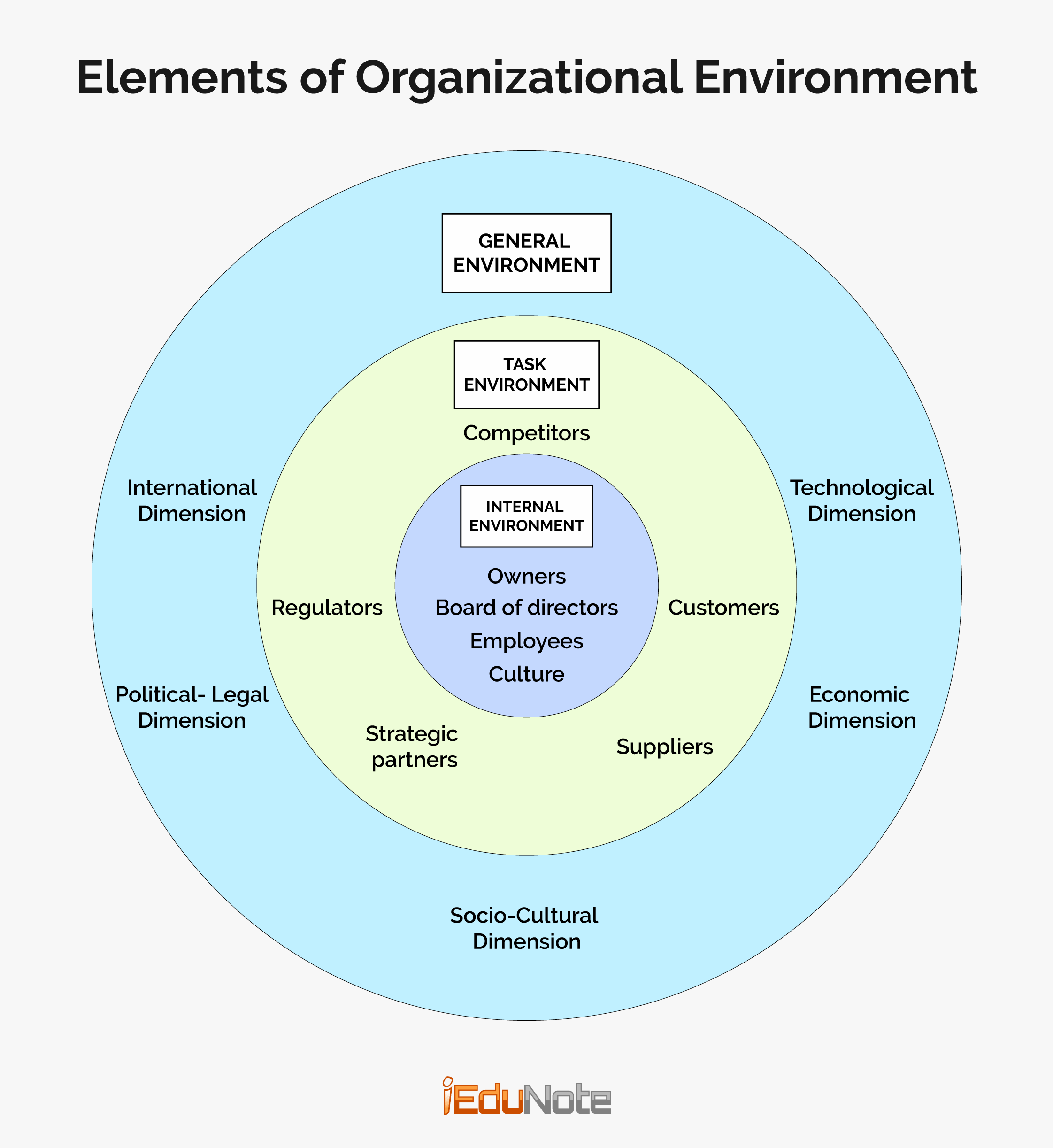Learn How Corporate Social Responsibility (CSR) to drive business success, benefit stakeholders, and thrive sustainably.
What is Corporate Social Responsibility?
A conflict between the interests of the stakeholder and the shareholder is endemic while addressing the issue of whose interests to prioritize. The provisioning to meet the interest of the stakeholders is seen as a dilution of the financial returns to the shareholders.
As a dominant institution of society, business is now expected to conduct itself in a manner that the negative impact of its economic behavior is reduced.
There is a reasoned logic in the assumption that business has to act voluntarily to emerge not only as a wealth-generating institution but also as a responsible, sensitive institution of society whose multiple resources and expertise can be used to improve human existential conditions.
The stakeholders expect the organization to optimize its economic, social, and ecological performance. The three are not isolated from each other but interlinked.
The economic performance expectations imply that the organization must undoubtedly be profitable. An unprofitable organization does not at all optimize the use of resources, most of which are no longer as freely available as before.
Beyond capital appreciation, the organization is expected to develop knowledge and intellectual capital, which can be harnessed to meet some of society’s legitimate but unmet needs (the solar kiosk in the last module is one such example).
Compliance with regulations is mandatory as the regulations are seen as safeguards for the larger interest and not controls on business. The organization has developed sufficient knowledge to comply and, at the same time, be profitable.
The economic role of business has the potential to create social disparities by concentrating more on wealth in the hands of some people. The role of business in the equitable distribution of economic benefits is accepted.
In 2012, many billionaires under the stewardship of Berkshire Hathaway founder Warren Buffet came forward to pledge large donations to global humanitarian causes.
Organizations are well-placed to develop programs for employee welfare and safety, encouraging disadvantaged groups to join the mainstream through inclusive growth or diversity enhancement programs.
Organizations are also well placed for further learning and sharing for the greater good.
Ecological concerns are gaining ground with the depletion of resources, climate change, and ecologic disasters such as the Exxon Valdez accident and methyl isocyanate leakage at the Bhopal plant of Union Carbide.
By applying the simple systems concept to the organization, we see that they consume resources at the input, transformation, and output stage. In the process, some of the natural resources get depleted.
Resource depletion and pollution are the two important consequences of the production of goods and services.
An ecological balance must be maintained in producing and consuming goods and services. This places the onus on responsible behavior on the organizations.
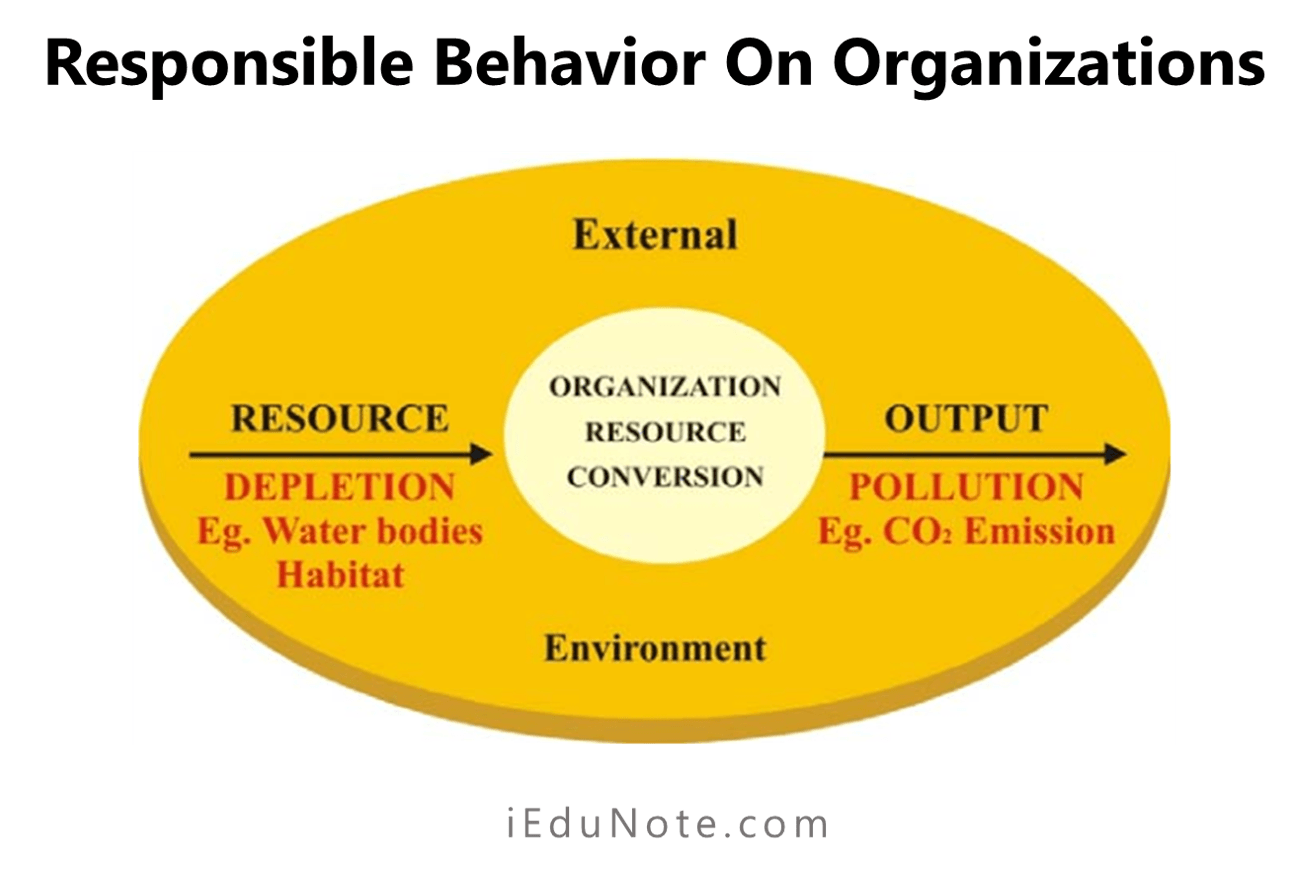
In your daily life, you perform several activities.
For example, brushing your teeth, listening to your parents, showing respect to elders obeying traffic rules on the road, etc. Now, why do you perform all these activities?
It is because you live in a family as well as in society, and the members of your family, as well as society, want you to do all of them. They do several things for you and expect something from you, which you must do.
The expectations of the family or society become your obligations, which you need to fulfill.
For example, taking care of your parents or children, keeping the road clean by not throwing garbage on it, etc. There are also obligations towards yourself that you need to fulfill.
For example, taking food timely, going to sleep early at night, etc., keeps you fit and takes care of your health. Now you fulfill all these obligations by performing certain activities which are called your responsibilities.
Any responsibility you have, particularly towards members of the society with whom you interact or towards society in general, is called your social responsibility.
This is true in the case of business also. As we know, every business operates within society.
It uses the resources of society and depends on society for its functioning. This creates an obligation on the business’s part to look after society’s welfare.
So all the activities of the business should be such that they will not harm. Rather, they will protect and contribute to the interests of society.
Social responsibility of business refers to all such duties and obligations of business directed towards the welfare of society.
These duties can be a part of the routine functions of carrying on business activity, or they may be an additional function of carrying out welfare activity.
Let’s take an example.
A drug-manufacturing firm undertakes extensive research and, thus, produces qualitatively superior drugs. It also provides scholarships or fellowships to the family members of its employees for studying abroad.
We find, in both cases, the drug-manufacturing firm is carrying out its social responsibility.
In the case of the former, it is part of its routine business function, while in the latter case, it is a welfare function.
According to UNIDO (United Nations Industrial Development Organisation), “Corporate Social Responsibility is a management concept whereby companies integrate social and environmental concerns in their business operations and interactions with their stakeholders.”
Corporate social responsibility implies a commitment of the organizations to be ethically, economically, socially, and ecologically responsive voluntarily.
This extends beyond regulatory compliance, and the actions taken thus are more than the compliance requirements. The voluntary compliance of social and ecological responsibility of companies is called Corporate Social Responsibility (CSR).
Definition of Corporate Social Responsibility (CSR)
The firms responsible for the welfare of their employees, customers, and communities are where their operations are. Certainly, firms have an ethical responsibility to provide a safe working environment, to avoid polluting the air or water, and to produce safe products.
Certain socially desirable actions such as pollution control, equitable hiring practices, and fair pricing standards may sometimes be inconsistent with earning the highest possible profit or achieving maximum valuation in the market.
Even though many socially responsible actions must be mandated by the government, in recent years, numerous firms have voluntarily taken such actions, especially in environmental protection, because they help sales.
Scholars’ View:
- Social responsibility is expected to provide long-run benefits to shareholders by maintaining positive stakeholder relationships. – L. J. Gitman
- Management has an ethical responsibility to sell products free of known defects and potentially harmful substances. – C. P. Jones
- Social responsibility is the concept that businesses should be actively concerned with the welfare of society at large. – Besley & Brigham
- Maximizing shareholder wealth does not mean management should ignore social responsibility, such as protecting the consumer, paying fair wages to employees, maintaining fair hiring practices & safe working conditions, supporting education, and becoming involved in such environmental issues as clean air and water. – Van Home & Wachowicz
However, socially responsible actions have costs, and not all businesses would voluntarily incur all such costs.
If some firms act in a socially responsible manner while others do not, then the socially responsible firms will be at a disadvantage in attracting capital. If one company attempts to exercise social responsibility, it will have to raise prices to cover the added costs.
If other firms in its industry do hot follow suit, their costs and prices will be lower.
So in finance, maximizing shareholder wealth does not mean management should ignore social responsibility such as protecting the consumer, paying fair wages to employees, maintaining fair hiring practices and safe working conditions, supporting education, and becoming involved in such environmental issues as clean air and water.
When society, acting through various representative bodies, establishes the rules governing the trade-off between social goals and economic efficiency, the task for the company is clearer.
We can then view the company as producing private and social goods or services, and maximizing shareholder wealth remains a viable corporate objective.
Concept of Social Responsibility in Business
We all know that people engage in business to earn a profit. However, profit-making is not the sole function of the business. It performs several social functions, as it is a part of society.
It takes care of those who are instrumental in securing its existence and survival, like the owners, investors, employees, consumers, and government in particular and the society and community in general.
So, every business must contribute in some way or the other for their benefit.
For example, every business must ensure a satisfactory rate of return to investors, provide a good salary, security, and proper working condition to its employees, make available quality products at a reasonable price to its consumers, maintain the environment properly, etc.
However, while doing so, two things need to be noted to view it as a nodal responsibility of business.
First, any such activity is not charity.
It means that if any business donates some money to any hospital, temple, school, college, etc., it is not to be considered as the discharge of social responsibility because charity does not imply fulfilling the responsibility.
Secondly, any such activity should not be such that it is good for somebody and bad for others.
Suppose a businessman makes a lot of money by smuggling or by cheating customers and then runs a hospital to treat poor patients at low prices; his actions cannot be socially justified.
Social responsibility implies that a business person should not do anything harmful to society during his business activities.
Thus, the concept of social responsibility discourages business people from adopting unfair means like black-marketing, hoarding, adulteration, tax evasion, cheating customers, etc., from earning a profit.
Instead, it encourages them to earn profit through judicious management of the business by providing better working and living conditions to its employees, providing better products, after-sales service, etc., to its customers, and simultaneously controlling pollution and conserving natural resources.
Why Should Businesses be Socially Responsible?
The concept of social responsibility of business was first mooted by President Wilson (USA) as early as 1913.
Social responsibility is a voluntary effort on the part of a business to take various steps to satisfy the expectation of different interest groups.
As you have already learned, the interest groups may be owners, investors, employees, consumers, government and society, or the community.
But the question arises as to why the business should come forward and be responsible for those interest groups. Let us consider the following points:
Public Image
Business activities towards the welfare of society earn goodwill and a reputation for the business. The business’s earnings also depend upon the public image of its activities.
People prefer to buy products from a company that engages itself in various social welfare programs. Again, a good public image also attracts honest and competent employees to work with such employers.
Government Regulation
To avoid government regulations, business people should discharge their duties voluntarily. For example, if any business firm pollutes the environment, it will naturally come under strict government regulation, which may ultimately force the firm to close down its business.
Instead, the business firm should engage itself in maintaining a pollution-free environment.
Survival and Growth
Every business is a part of society. So for its survival and growth, society’s support is essential. The business utilizes the available resources like power, water, land, roads, etc. of the society.
So it should be the responsibility of every business to spend a part of its profit for the welfare of society.
Employee Satisfaction
Besides getting a good salary and working in a healthy atmosphere, employees also expect other facilities like proper accommodation, transportation, education, and training.
Employers should try to fulfill all the expectations of the employees because employee satisfaction is directly related to productivity, and it is also required for the organization’s long-term prosperity.
For example, if a business spends money on training employees, it will have more efficient people to work thus, earn more profit.
Consumer Awareness
Nowadays, consumers have become very conscious of their rights. They protest against the supply of inferior and harmful products by forming different groups.
This has made it obligatory for the business to protect the interest of the consumers by providing quality products at the most competitive price.
Triple Bottom Line Approach for CSR
For being socially responsible, the triple-bottom-line approach is also advocated. The phrase” “Triple Bottom Line” was coined by John Elkington in his book Cannibals with Forks: the Triple Bottom Line of 21st Century Business, published in 1997.
3 Ps imply people, profits, and the planet.
The idea of the 3P approach is that people, planet, and profits are interlinked. People are not only employees but also that outside. The 3P organization does not make decisions that harm or exploit the people (exploitation includes the employment of child labor or unfair employment practices). The planet refers to the ecological environment. The 3P organization is sensitive about the ecologic footprints its consumption may leave, so it refrains from manufacturing that is ecologically disastrous or unsustainable.
A life cycle assessment of its products is carried out to facilitate disposal. Profits are the economic returns.
The return is not just the accounting return but also the return earned on good practices. The 3P approach considers the argument that involvement with sustainability and community renders businesses unprofitable, as being untenable.
The triple bottom line approach was first used in the corporate context by the Shell Group in its 1997 sustainability report. Sustainability was first defined by the Brundtland Commission of the United Nations in 1987.
Corporate Social Responsibility (CSR) in Finance
The firms may exercise social responsibility toward their constituents, environment, and social welfare.
1. Organizational Constituents
The people who own and invest in a firm are affected by virtually anything the firm does. Firms also have a responsibility to their creditors. If poor social performance hurts the firm’s ability to repay its debts, those creditors and their employees will suffer.
To maintain a socially responsible stance toward finances, managers should follow proper accounting procedures, provide appropriate information to shareholders about the firm’s financial performance and manage the firm to protect shareholder rights and investments.
2. Natural Environment
An area of social responsibility relates to the natural environment. Many firms indiscriminately dump sewage, waste products from products, trash into streams and rivers, air, and vacant land. However, many laws regulate the disposal of waste materials.
3. Social Welfare
Business firms should also promote society’s welfare, including making contributions to charities, philanthropic firms non-profitable organizations and taking a role in improving education and public health.
Social Responsibility Model
For its societal strategy to be meaningful, an organization needs to decide upon the following:
- The extent of its involvement – from reactive to proactive, is shown as ‘A.’
- The choice of the area it will serve beyond regulatory compliance is shown as ‘B.’
- The resources it will commit to the area/ issue are shown as ‘C.’
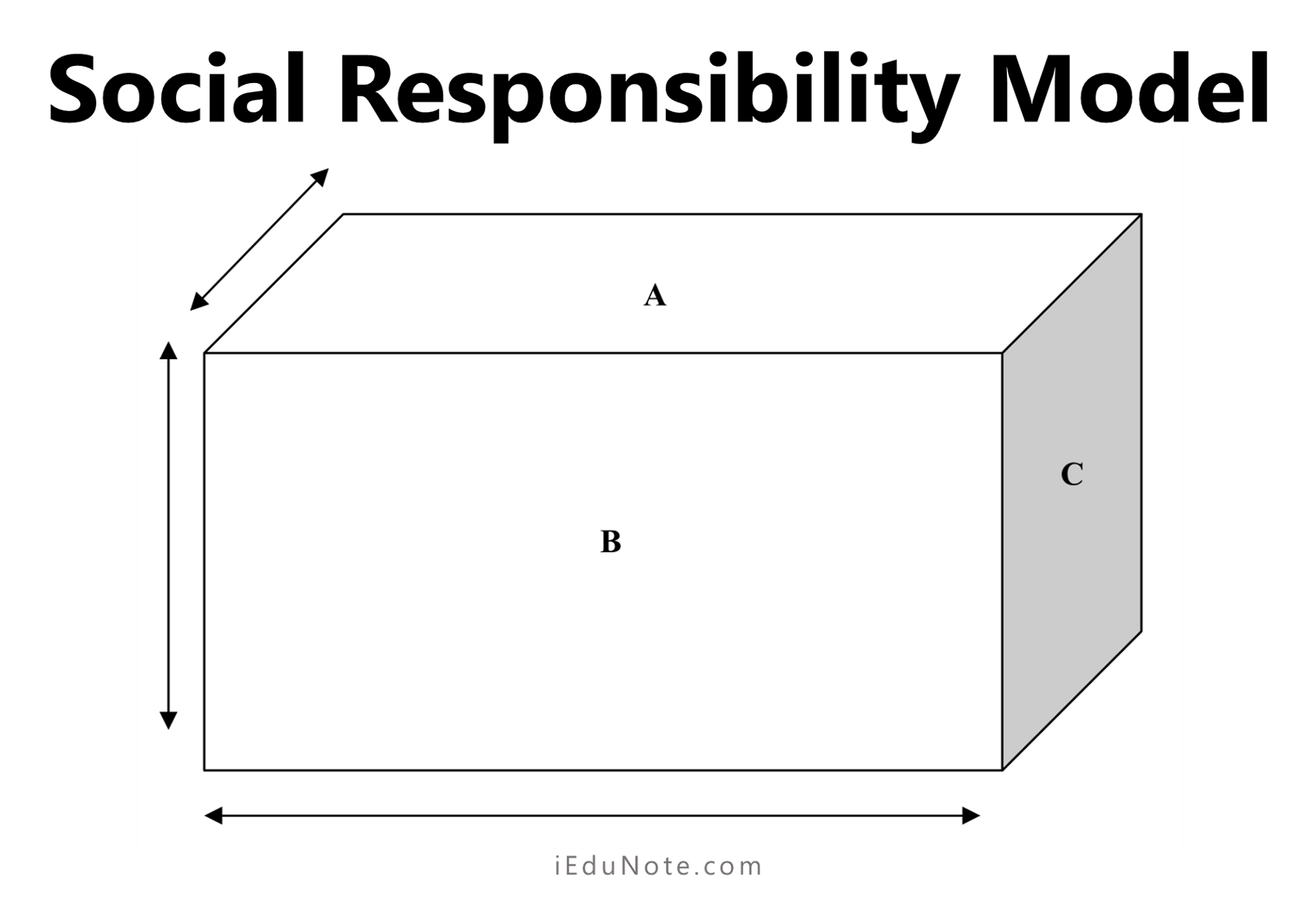
The extent of the organization’s involvement implies whether it seeks a proactive or reactive posture. Usually, the earlier behavior of the business organizations has indicated that they chose to be reactive rather than proactive.
The wisdom of being reactive was that the business of business is business, and the organizations should not commit action and resources until compelled to do so.
Unless there was a compulsion, there was no sense in taking any decision as any proactive behavior would only invite more restrictions.
The demands placed on a business evolve. Usually, there is a pattern in the emergence of demand. Let us consider the issue of automotive emissions.
First, awareness at large is created about the harmful effects of the emissions, the expectation of action follows the awareness, and some organizations may respond to it and use it as a differentiating factor. Most others do not respond.
There is some dormancy for the issue, and then the demand for action rises, and then enforcement through legislation is enforced. The corporate response is evolutionary and not ad hoc.
However, some organizations are more proactive than reactive.
Even in the case of regulations, some organizations may set the bar beyond just regulatory compliance because, as society learns, the acceptable levels of behavior also change.
Whether the organization will be proactive or reactive depends on managerial knowledge and awareness, the type of industry the business organization is in, and the organization’s economic health.
The choice of the area to be served
Organizations cannot meet all the expectations.
However, all organizations can meet all the expectations by staggering them among themselves and meeting those for which the organization has the complementary skill and competency set.
Having fulfilled the various regulatory requirements, an organization may choose to address the issues of ecological, social, governance, or economic segments in its environment.
The choice would depend upon the sector’s relevance to the business, the environmental driving the attention to the cause/ issue, the skill set that an organization has, and the kind of changes it can bring about.
Resource Commitment
Engagement with any issue of concern involves resource commitment.
The organization has to decide how much time, money, workforce, goodwill, and skills to commit to the cause. The top management usually determines the commitment to the issue.
For example, a carbonated cold drinks manufacturer locates its plant in an area with low water table.
The manufacturer will inevitably consume water and lower the water table still further. This action is a cause of community resentment.
In the perception of the community, the organization has claimed resources for its commercial use, and, naturally, it does something to restore the water table.
With the area being water-scarce, the actions of the organization attract negative publicity.
At this juncture, the organization may treat it as more of a public relations exercise and highlight some cosmetic action.
These will provide temporary respite. The involvement of senior managers and the highlighting of the issue to the top management elicit a different response.
The organization develops a long-term plan of water management with the active involvement of the local community and government department experts.
It initiates voluntary action to improvise measures to recharge round water and educates the local community on simple measures they can adopt for recharge and conservation.
It funds those initiatives. The organization decides to address sustainable agriculture issues and the restoration of traditional water bodies and water harvesting systems.
These concerns are aligned with the organization’s business interest and, at the same time, are relevant to the community.
Some of the social initiatives are economically very beneficial, such as the promotion of energy efficiency or recycling. These can be aligned with the competitive strategy.
For example, recycling may reduce costs and also lead to differentiation. Many organizations adopt such measures as the first steps toward social responsibility. This serves two purposes.
First, such programs can be aligned with the existing operational programs of the organization.
Secondly, the success of such programs reduces managerial skepticism and makes acceptance of subsequent programs easier. The programs are not seen as wasteful of time.
Process of Societal Strategy Formulation
Societal strategy formulation, like corporate strategy formulation, is a complex process. It has a political dimension as well as an analytical one.
On the one hand, there are the aspirations of the stakeholders. Resources and managerial choices impose constraints. The constraints that are already in place have an impact on the societal strategy.
For example, the existing norms for effluent treatment or emissions in many countries will impact the strategy’s performance in those areas.
If the regulations are strict and the price of non-compliance is high, it will be served whether the segment is on the managerial agenda. The resources consumed after fulfilling the obligations will be allocated to other areas.
A large part of the societal budget may be consumed in compliance with existing regulations.
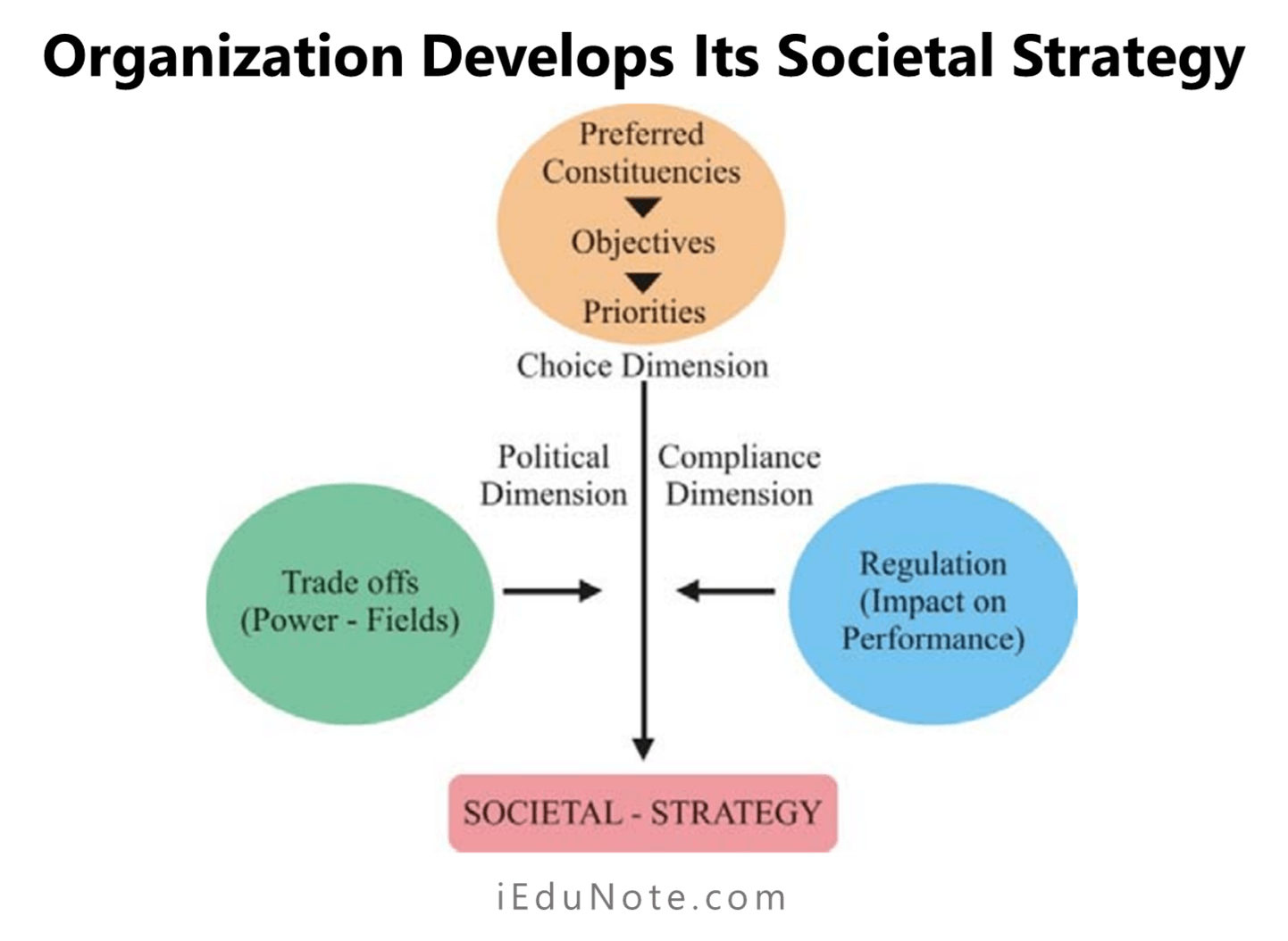
Within these constraints, shown as choice political and compliance dimensions, the organization develops its societal strategy to serve either the cause of socio-efficiency or eco-efficiency or a combination of the two.
The example of the cola manufacturer above is a combination of both socio and eco-efficiency. At the functional level, the organization takes up those actions to be integrated with operations.
Some operationally-oriented functional-level strategies are sustainable procurement, mandatory disclosures, life cycle approach, sustainability reporting, and sustainability audit.
These are integral to procurement and compliance in areas such as effluent disposal, operations, finance, and marketing. Adopting these in an integrated manner serves an organization better than a disjointed or segregated adoption.
For example, if Wal-Mart follows the strategy of responsible procurement and labels its products as being sourced from women for a cause and the sustainability accounting apportions cost as a sustainable cost.
The picture within the organization about the rationale of the action and its financial accountability is clearer than if procurement was a standalone exercise taken up sporadically.
These functional strategies have to be integrated with business-level strategies.
For example, sustainable procurement and sustainable accounting are linked, and the procurement indices and percentages should be a part of the overall procurement rather than a standalone exercise.
In a competitive world, only those organizations that serve the niche market for sustainable products can compete only using sustainable materials.
Gradually, as customer awareness increases and they accept the need to pay more if need be, the sustainable index in procurement can be increased.
Thus customer awareness will have to be a part of the sustainability strategy.
However, there is an emerging market for sustainable products such as cars (electric) for which a different set of strategies would work and where the entire value chain will be configured with different players following the same ethos.
Linking the social agenda of business with strategic management may be a complex exercise but not impossible. How the agenda can be a part of the overall strategy should be done from the initial stages to minimize resistance as the organization scales up its sustainability actions.
This figure sums up the different stages an organization may go through before the societal strategy is fully operational.
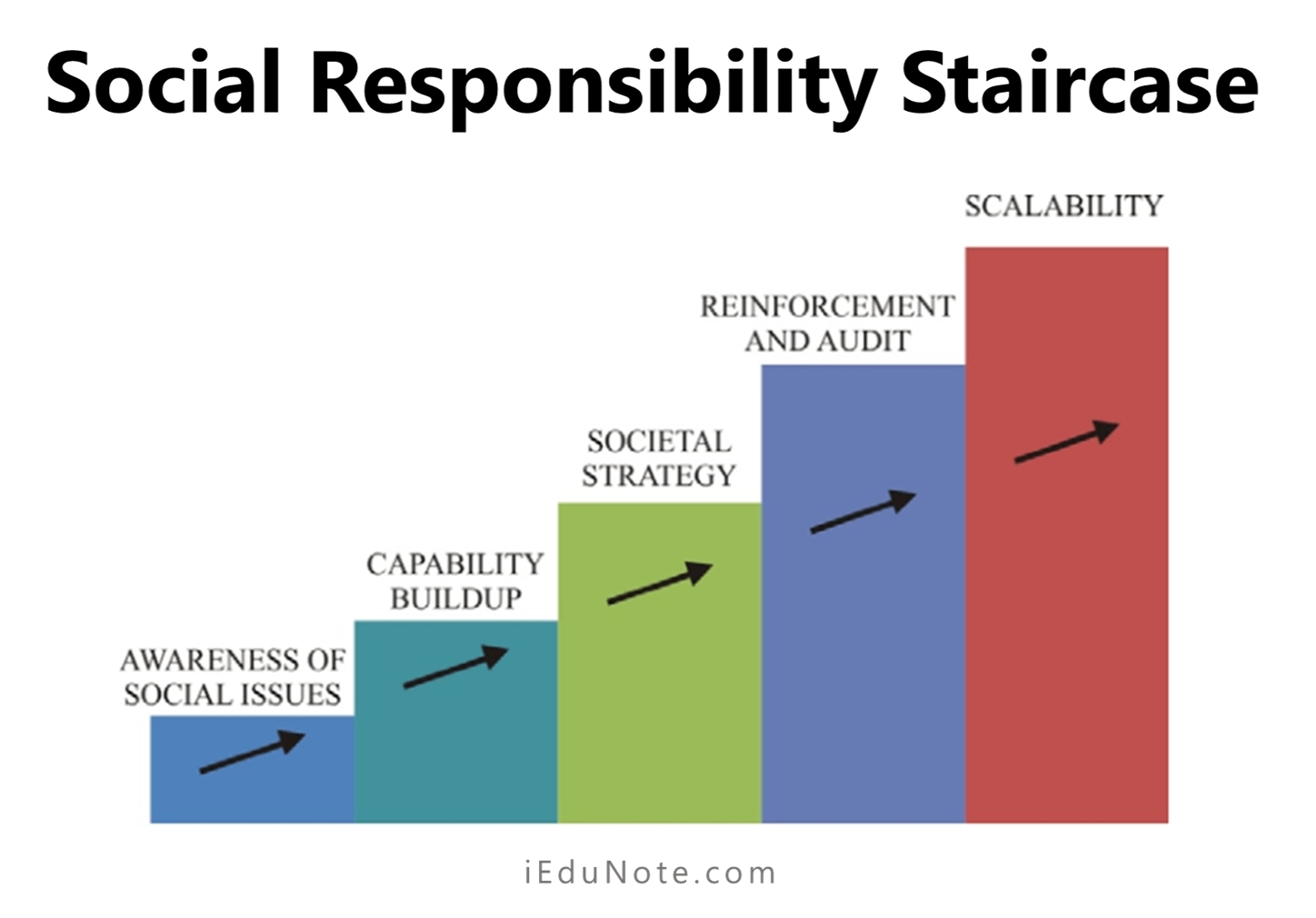
During the first stage, awareness of social issues is what is of concern either because it has been made imperative or because the organization’s pro-activism has shielded it from an ad hoc response to the imperative. It can choose its area of focus.
Once the issues are identified, the capability build-up begins with management support and resource commitment (as explained in the case of Walmart and Huawei and analysis of the process of responsiveness).
Articulation of societal strategy, which is an outcome of the political, regulatory, and choice dimensions, is done. The measures for societal strategy may be simple numbers to begin with.
Over time, the organization leverages these across functions to enhance its performance and impact. Reinforcement and audits are done when the organization begins to make resource commitments.
Having run a pilot with the steps mentioned above, the organization replicates the same issue or another in a larger segment of the organization.
Responsibility Toward Different Interest Groups
After getting some idea about the concept and importance of social responsibility of business, let us look into the various responsibilities that a business has towards different groups with whom it interacts.
The business generally interacts with owners, investors, employees, suppliers, customers, competitors, the government, and society.
They are called interest groups because, by every activity of a business, the interest of these groups is affected directly or indirectly.
Responsibility Towards Owners
Owners are the persons who own the business. They contribute capital and bear the business risks.
The primary responsibilities of a business towards its owners are to:
- Run the business efficiently.
- Proper utilization of capital and other resources.
- Growth and appreciation of capital.
- A regular and fair return on capital invested.
Responsibility Towards Investors
Investors are those who provide finance by way of investment in debentures, bonds, deposits, etc. Banks, financial institutions, and investing public are all included in this category.
The responsibilities of a business towards its investors are:
- Ensuring the safety of their investment,
- Regular payment of interest,
- Timely repayment of the principal amount.
Responsibility Towards Employees
Business needs employees or workers to work for them. These employees put in their best effort for the benefit of the business. So it is the prime responsibility of every business to take care of the interest of its employees.
Only the business can be successful if the employees are satisfied and efficient. The responsibilities of a business towards its employees include:
- Timely and regular payment of wages and salaries.
- Proper working conditions and welfare amenities.
- Opportunity for better career prospects.
- Job security as well as social security like facilities of provident fund, group insurance, pension, retirement benefits, etc.
- Better living conditions like housing, transport, canteen, creches, etc.
- Timely training and development.
Responsibility Towards Suppliers
Suppliers are businessmen who supply raw materials and other items manufacturers and traders require. Certain suppliers, called distributors, supply finished products to consumers.
The responsibilities of business towards these suppliers are:
- Giving regular orders for the purchase of goods.
- Dealing with fair terms and conditions.
- Availing of a reasonable credit period.
- Timely payment of dues.
Responsibility Towards Customers
No business can survive without the support of customers. As a part of the responsibility of the business towards them, the business should provide the following facilities:
- Products and services must be able to take care of the needs of the customers.
- Products and services must be qualitative.
- There must be regular ty in the supply of goods and services.
- The price of goods and .ervices should be reasonable and affordable.
- All the advantages and disadvantages of the product, as well as the procedure to use the products, must be informed to the customers.
- There must be proper after-sales service.
- Grievances of the consumers, if any, must be settled quickly.
- Unfair means weighing the product, adulteration, etc., must be avoided.
Responsibility Towards Competitors
Competitors are other businessmen or organizations involved in a similar type of business.
Competition helps the business become more dynamic and innovative to make itself better than its competitors.
It also sometimes encourages the business to indulge in negative activities like resorting to unfair trade practices. The responsibilities of business towards its competitors are:
- not to offer exceptionally high sales commission to distributors, agents, etc.
- Not to offer customers heavy discounts and /or free products in every sale.
- Not to defame competitors through false or ambiguous advertisements.
Responsibility Towards Government
Business activities are governed by the rules and regulations framed by the government. The various responsibilities of business towards government are:
- Setting up units as per guidelines of the government
- Payment of fees, duties, and taxes regularly as well as honestly.
- Not to indulge in monopolistic and restrictive trade practices?
- Conforming to pollution control norms set up by the government.
- Not to indulge in corruption through bribing and other unlawful activities.
Responsibility Towards Society
A society consists of individuals, groups, organizations, families, etc.
They all are members of society. They interact with each other and are also dependent on each other in almost all activities. There exists a relationship between them, which may be direct or indirect.
Business, being a part of society, also maintains its relationship with all other members of society.
Thus, it has certain responsibilities towards society, which may be as follows:
- to help the weaker and backward sections of the society
- to preserve and promote social and cultural values
- to generate employment
- to protect the environment
- to conserve natural resources and wildlife
- to promote sports and culture
- to assist in the field of developmental research on education, medical science, technology, etc.
Social responsibility starts where the legal system ends. And CSR can be internal as well as external to a business organization.

